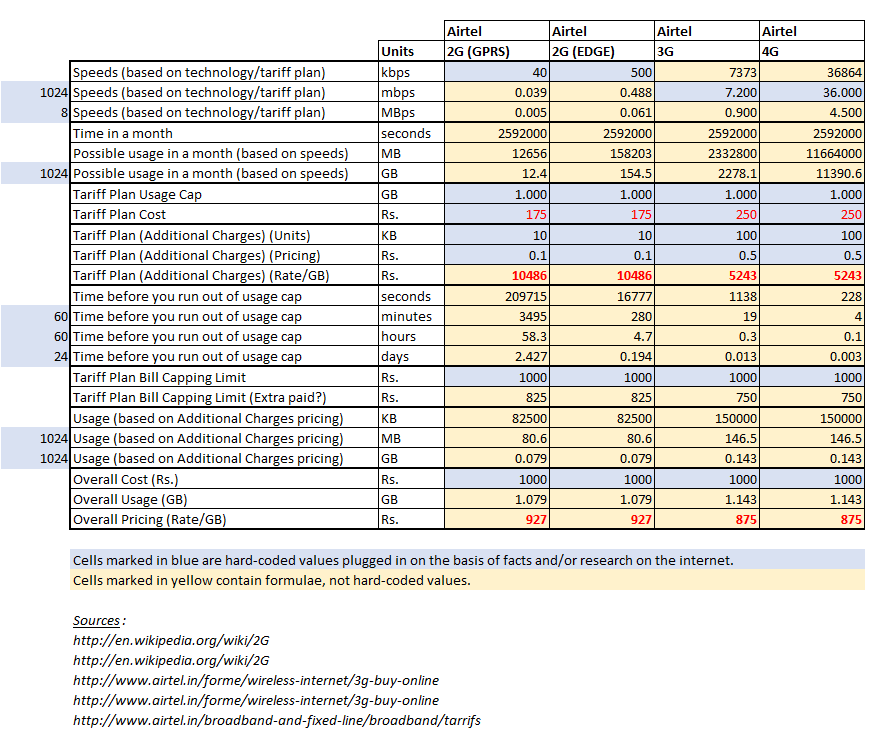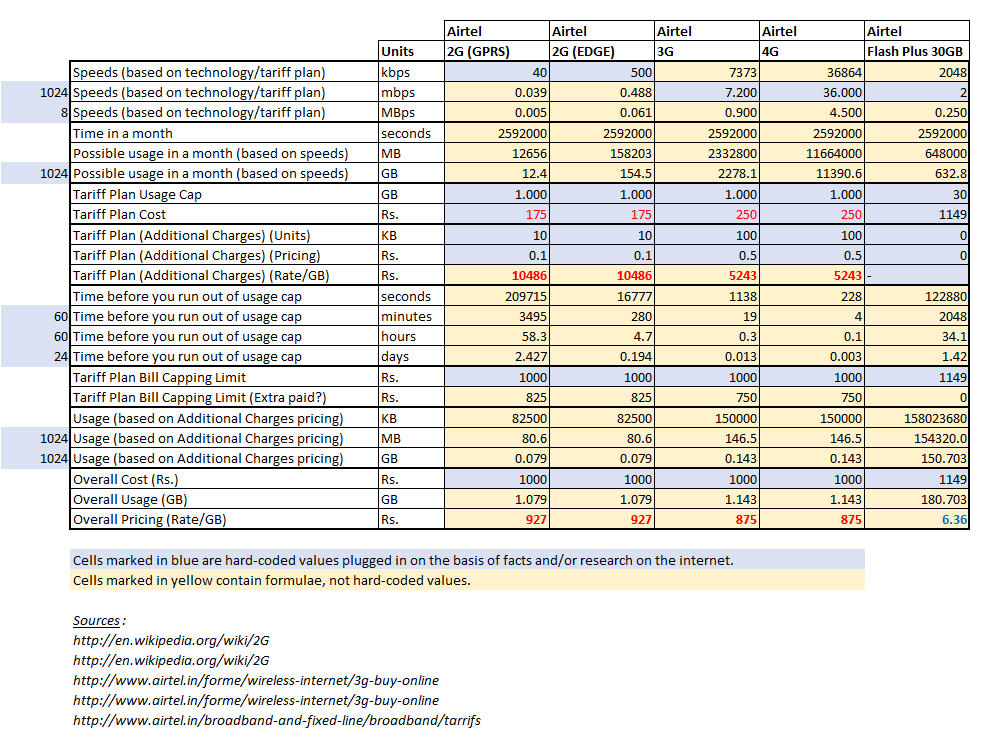Apart from Mobile Internet in India, is there anything else you pay a 1600x price differential for?
Those of you who know me in real life know how important a role the Internet plays in my life. Over the years, I’ve ended up building simple Excel models that allow me to check which broadband plan offers the best value for money, viz. how much bang for the buck am I getting when it comes to Internet service? You can find one of my older models here.
Now, you should know that I’m not necessarily a big fan of Internet speeds – a tariff plan needs to be measured on its merits, and high mbps speeds advertised through marketing collateral are more of a gimmick than real value for money. If you haven’t done the math, and chances are, most of you haven’t, you’d be surprised at how quickly the so-called advantage of speed becomes a disadvantage (once you realize that the extra money you pay is for the novelty of higher speeds).
Now, let’s look at the mobile Internet space in India. I’m sharing a brief table below that showcases the tariffs for mobile Internet, looks at the speeds that the technology supports (or that the mobile operator communicates), and shows you how expensive mobile Internet really is compared to traditional Internet broadband.

Wikipedia states that there are two types of 2G, GPRS and EDGE, both with different speeds. If we look at 2G (GPRS), for instance, we find that based on speeds of 40 kbps, an always-on connection over the course of 1 month (or 30 * 24 * 60 * 60 = 2,592,000 seconds) would end up downloading 12.4 GBs (approximately 12,656 MB). However, since your tariff plan is capped at 1 GB, you would never be able to utilize the speed to its full potential.
The table also shows you something more interesting – if your mobile connection is kept always-on, how long does it take to hit the tariff plan limit?
In the case of 2G (GPRS), the 1 GB limit is reached in 58.3 hours (or just under 2.5 days). Similarly, an always-on 2G (EDGE) connection hits 1 GB in 4.7 hours, a 3G connection hits the 1 GB limit in 19 minutes, and a 4G connection (as claimed by Airtel to be 5 times faster than 3G) hits the 1 GB limit in less than 4 minutes (228 seconds to be precise).
Now, let’s see what happens after you hit the 1 GB limit. For many plans, there is a billing cap that’s usually kept to Rs.1000/month, but it has a different pricing structure (not the same Rs.175/GB or Rs.250/GB as the first GB is priced). You really need to break down this pricing to understand how criminally overpriced these rates are.
2G pricing (beyond the first GB, and up to the bill limit) is 10p per 10 KB. Multiply that by 100 to get Rs.10 per 1000 KB. That’s approximately Rs.10 per MB, which makes it a whopping Rs.10,000 per GB. The actual numbers (if one were to use a factor of 1024 to convert between GB and MB, or MB and KB, as I have done), come to Rs.10,486 per GB.
Yes, you read that right.
The same plan that offers you the first GB for Rs.175, charges you at the rate of Rs.10,486 per GB for additional usage. Needless to say, your additional Rs.825 (till your bill limit is hit) doesn’t buy you much data – merely about 80.6 MBs (approximately 0.079 GB).
Sure, one might say that after the bill limit is reached, operators don’t charge you anything extra, and you get to keep using your data connection, so that’s good. Well, you just paid Rs.1000 for the first 1.079 GB, which comes to a cost of Rs.927/GB, post which you are allowed to get unlimited Internet for free for the rest of the month at speeds of 40 kbps (that’s 5 KBps, in the regular parlance you and I use, just so you know). I don’t know about you, but that doesn’t seem anything like a good deal to me.
Similarly, 3G and 4G plans cost slightly higher at Rs.250 for the first GB, and they have a lower rate when it comes to usage beyond the 1 GB. They are priced at 50p for 100 KB. Multiply by 10 to get Rs.5 per 1000 KB. That’s approximately Rs.5 per MB, or an approximate price of Rs.5000 per GB. The actual numbers (based on the factor of 1024 used), come to Rs.5243 per GB.
Due to this *relatively* lower cost, the remaining Rs.750 (based on your Rs.1000 bill limit) goes a longer way. Instead of the 80.6 MBs you were able to use on 2G, you are now able to use 146.5 MBs on your 3G or 4G connection for the Rs.750 that’s left in your billing before you hit the cap. Overall, your Rs.1000 bill gets you 1.143 GBs, at a *relatively* cheaper rate of Rs.875/GB.
However, before we proceed, let’s be clear on one thing about billing caps for mobile Internet plans. A user who opts for a Rs.250 for 1 GB plan isn’t looking to maximize his total usage by paying Rs.875 or Rs.927 per GB till he hits Rs.1000, and then going overboard by using the rest of the bandwidth for free. The billing cap, was in most likelihood, put in place because customers were being charged unbelievable amounts (can you imagine running up a bill for Rs.10,661 just because you used 2 GBs, or Rs.21,147 just because you used 3 GBs?). After a lot of fire-fighting with customers who felt they were getting robbed blind (which they were, and are), operators put this cap in place to make sure they don’t lose customers to outrageous billing practices.
So let’s realize what the billing cap really is – it’s not a safety net, since a safety net is supposed to save you from overspending. A billing cap that’s 4x to 5x away from the basic plan tariff is *not* a safety net, by any definition. The mobile Internet billing cap is, in its truest form, an arrangement that lets operators charge you 4x to 5x of what you’ve opted to pay, by providing you for that additional money, the least possible amount of data usage that they possibly can.
Now, let’s do something more fun by putting this in context of how much accessing the Internet costs on your broadband connection.
Airtel has a tariff plan called Flash Plus 30 GB, which is one of the Fast plans available in Bangalore (Faster and Fastest plans have higher starting speeds, and higher starting tariffs). I’m guessing this Flash Plus 30 GB is their cheapest broadband plan in the city. For a monthly tariff of Rs.1149, this plan gives you speeds of 2 mbps, up to a limit of 30 GBs, after which the speed is downgraded to 512 kbps. Based on 2 mbps speeds, you can see that you run out of 30 GBs in 34.1 hours, or just under 1.5 days. What happens once the limit is hit? You continue using the connection at a reduced speed, but no additional cost. An always-on connection on this plan, in the remaining 28.5-odd days, would end up covering another 150.7 GBs of usage. This means that for Rs.1149, as a user you get the original 30 GBs plus another 150.7 GBs, which is equal to 180.7 GBs.
Effective cost? A mere Rs.6.36 per GB.

Now compare the Rs.6.36/GB on your broadband to Rs.175/GB (28x) or Rs.250/GB (39x) or Rs.875/GB (138x) or Rs.927/GB (146x) or Rs.5243/GB (825x) or Rs.10,486/GB (1649x).
Is there a difference in what you use your broadband or mobile Internet for?
You use the same Facebook, the same Whatsapp (there’s Whatsapp on the web now that you can use over wi-fi), the same YouTube.
Is there a difference in the accessibility to Internet sites that you get via your broadband vs your mobile Internet?
No.
Is there a difference in what you think Airtel has to pay for carrying traffic from broadband users vs mobile Internet users, to whichever Internet pipe service they are using to connect to the rest of the world (presuming they haven’t built the pipe themselves)?
No.
Ladies and gentlemen, there is only one difference here.
One type of Internet reaches you via broadband wiring (which, again, Airtel has incurred costs to lay), and the other reaches you via their mobile network.
The way economies of scale works as a principle, and it works everywhere, is that the more you use, the cheaper it gets. If there is no difference in the first GB and the rest of the GBs, then why are GBs beyond the first GB charged at Rs.10,486/GB, and not a price lower than Rs.175/GB?
Do you think *any* technology that is so overpriced in terms of actual cost, can and should still survive? Or do you think all these are pricing decisions, delinked from the true inherent costs of running the business?
Cabs compete with rickshaws by dropping tariffs, airlines compete with trains by dropping prices, online portals compete with brick-and-mortar stores by providing deep discounts – and mobile Internet pricing doesn’t even try to compete with broadband Internet pricing?
For what is, essentially the *exact same service* of providing data usage (both from the user’s point of view, and also from the telecom operator’s point of view of paying for that traffic to a third-party who connects the telecom operator to the rest of the world), every day, Airtel and other Indian telecom operators instead choose to maintain a 1600x price differential!
Notes:
• This doesn’t even look at the fact that mobile operators usually measure *both* your download and upload traffic, and charge you for data usage on the combined total, whereas broadband Internet charges you only on the basis of download data usage.
• This analysis looks at the basic entry-level plans and corresponding tariffs – it would be correct to presume that if one were to move up the tariff plan range, the effective pricing for GBs would decrease, but it would still be far, far, far more expensive than it ought to be.
• The reason I’ve looked at Airtel is multi-fold –
1. Airtel is the best example around when it comes to providing both mobile and broadband Internet services.
2. With Airtel Zero in the news, it made sense to focus on Airtel’s take on pricing.
3. I’ve been an Airtel mobile user for over a decade now, and have used Airtel broadband for some years too.
• b stands for bit/bits
• B stands for Byte/Bytes
• conversion between b and B has been done using a factor of 8 (1 B = 8 b)
• conversion between K and M has been done using a factor of 1024 (1 m = 1024 k)
• conversion between MB and GB has been done using a factor of 1024 (1 GB = 1024 MB)
• 1 month has been considered as 30 days